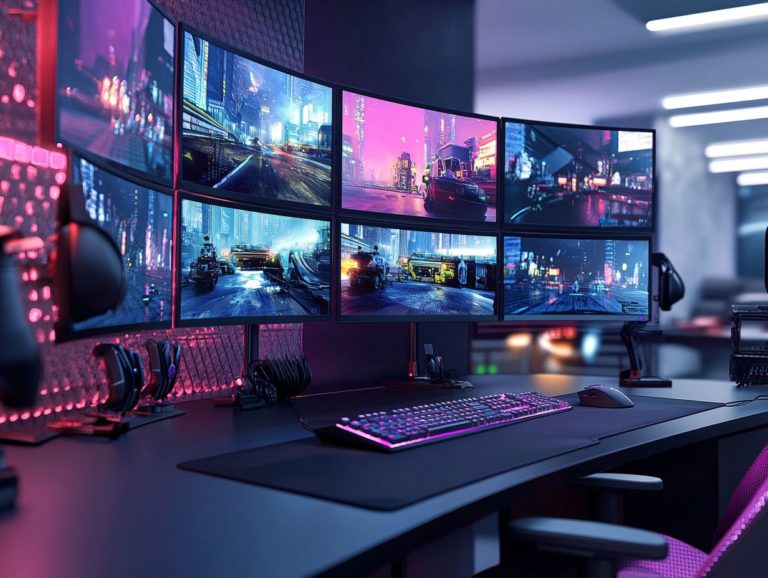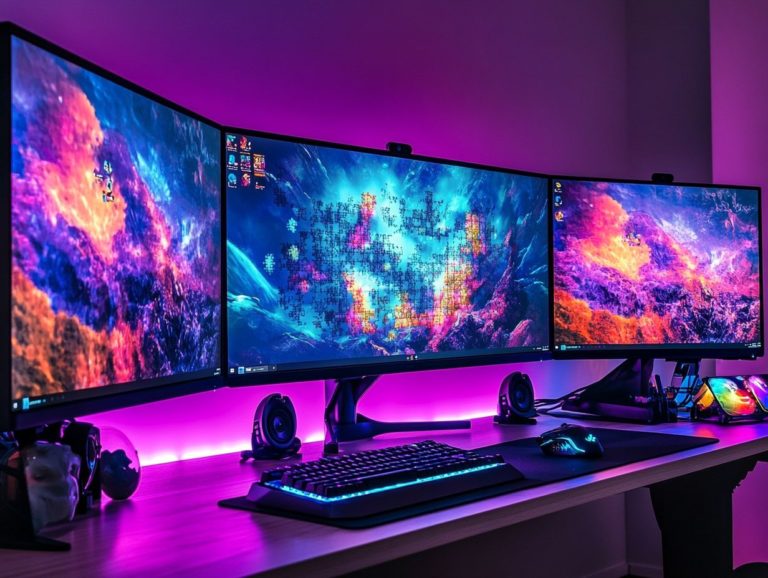the role of contrast ratio in gaming monitors
In the realm of gaming, every detail is crucial. One key element that shapes your visual experience is the contrast ratio.
This measurement affects how vibrant your game looks, directly impacting your overall immersion. Understanding contrast ratio can elevate your visuals and give you a competitive edge.
This article explains contrast ratio, its importance in gaming, factors that influence it, and how to optimize your gaming monitor settings. Get ready to take your gaming experience to the next level!
Contents
- Key Takeaways:
- Understanding Contrast Ratio
- The Importance of Contrast Ratio in Gaming
- Factors Affecting Contrast Ratio
- How to Choose the Right Contrast Ratio for Gaming
- Maximizing Contrast Ratio in Gaming Monitors
- Other Considerations for Gaming Monitors
- Frequently Asked Questions
- What is the role of contrast ratio in gaming monitors?
- How does the contrast ratio affect image quality in gaming monitors?
- What is a good contrast ratio for gaming monitors?
- How can a high contrast ratio improve gaming performance?
- Can the contrast ratio be adjusted on a gaming monitor?
- Are there any downsides to having a high contrast ratio in gaming monitors?
Key Takeaways:
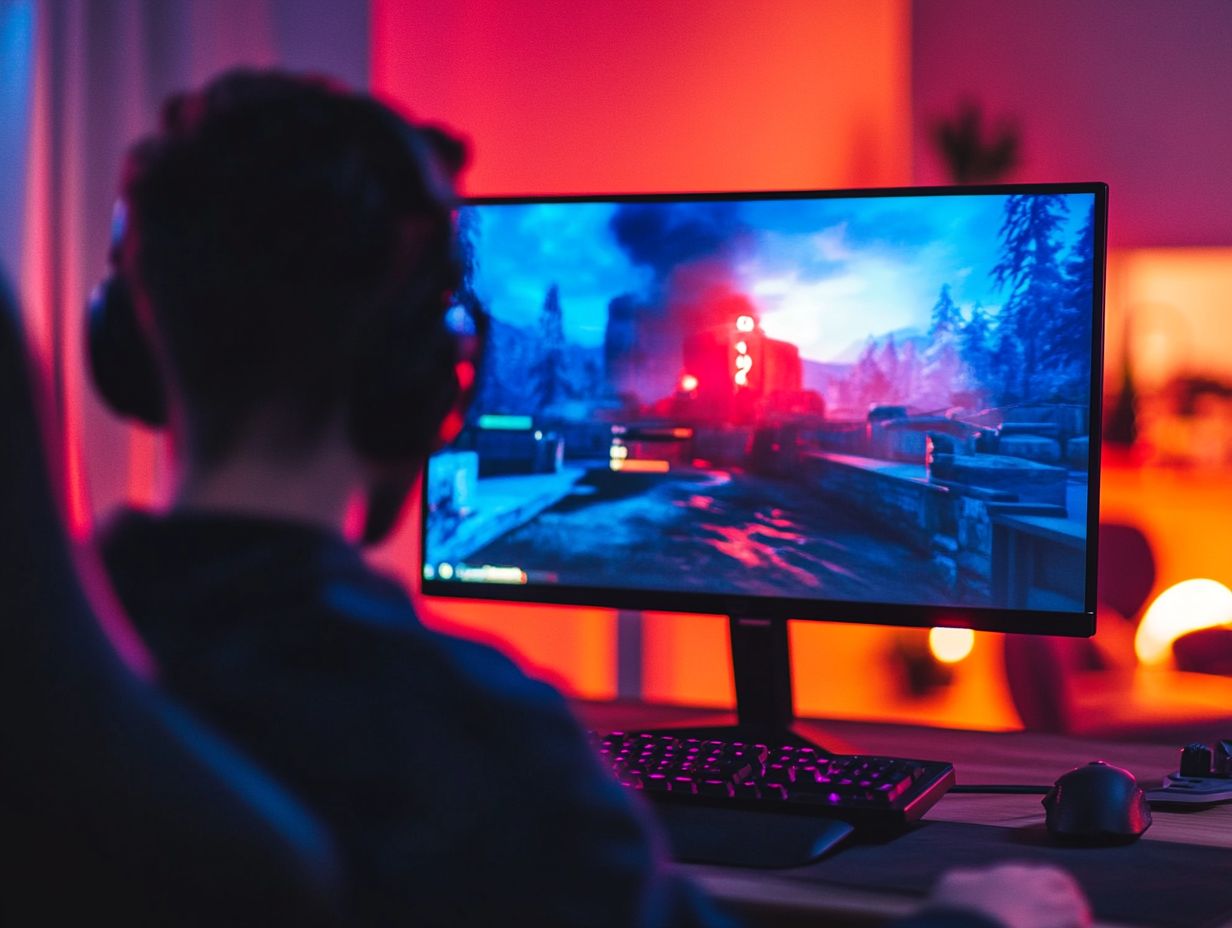
Contrast ratio measures the difference between the darkest and brightest colors on your screen. It significantly impacts your visual experience, making it crucial for gamers.
Display technology and monitor settings affect contrast ratio. Choosing the right one is important for optimal performance.
To maximize contrast ratio, optimize your monitor’s settings. Also, consider resolution and refresh rate.
Understanding Contrast Ratio
Understanding contrast ratio is important for anyone invested in monitor performance, especially gaming enthusiasts and visual arts professionals.
This metric defines the difference between the darkest blacks and the brightest whites your display can produce.
It significantly influences image quality, affecting everything from routine tasks to immersive gaming experiences.
A high contrast ratio sharpens visual clarity and enriches blacks, making it essential when selecting a gaming monitor.
What is Contrast Ratio?
The contrast ratio compares the brightness levels between the brightest whites and the darkest blacks your monitor can produce.
This ratio is vital for assessing display quality, impacting color richness and detail.
To calculate it, divide the brightness of the brightest white by that of the darkest black, resulting in values like 1000:1.
For example, a monitor with a 2000:1 contrast ratio delivers deeper blacks than one with a 1000:1 ratio. This is particularly beneficial for activities like graphic design and gaming.
Brightness variations across different settings can influence perceived contrast. Ambient light and display adjustments are key factors affecting performance.
The Importance of Contrast Ratio in Gaming
The importance of contrast ratio in gaming is profound. It enhances your gaming experience by improving image quality.
A high contrast ratio helps you see sharp details, even in dark scenes, making every moment more captivating.
With HDR displays, the demand for monitors with exceptional contrast ratios has surged. These monitors offer deeper blacks and vibrant colors, enriching the gaming experience.
For dedicated gamers, choosing a monitor with a high contrast ratio is essential for both competitive play and enjoyment.
Enhancing Visuals and Gaming Experience
Understanding contrast ratio enhances visuals in gaming and plays a crucial role in your immersion. Additionally, exploring the role of HDR in gaming monitors can significantly improve your overall enjoyment.
As you learn more, you’ll uncover techniques like local dimming. This feature selectively dims parts of the screen, allowing for richer blacks and brighter highlights.
Calibration settings are also vital. Adjusting brightness, color balance, and sharpness can dramatically improve your gaming experience.
Color depth matters too. A higher color depth provides a broader spectrum, resulting in smoother gradients and a more vibrant image.
Considering these factors together elevates visual quality, enhancing your gaming experience and immersing you further in game worlds.
Factors Affecting Contrast Ratio
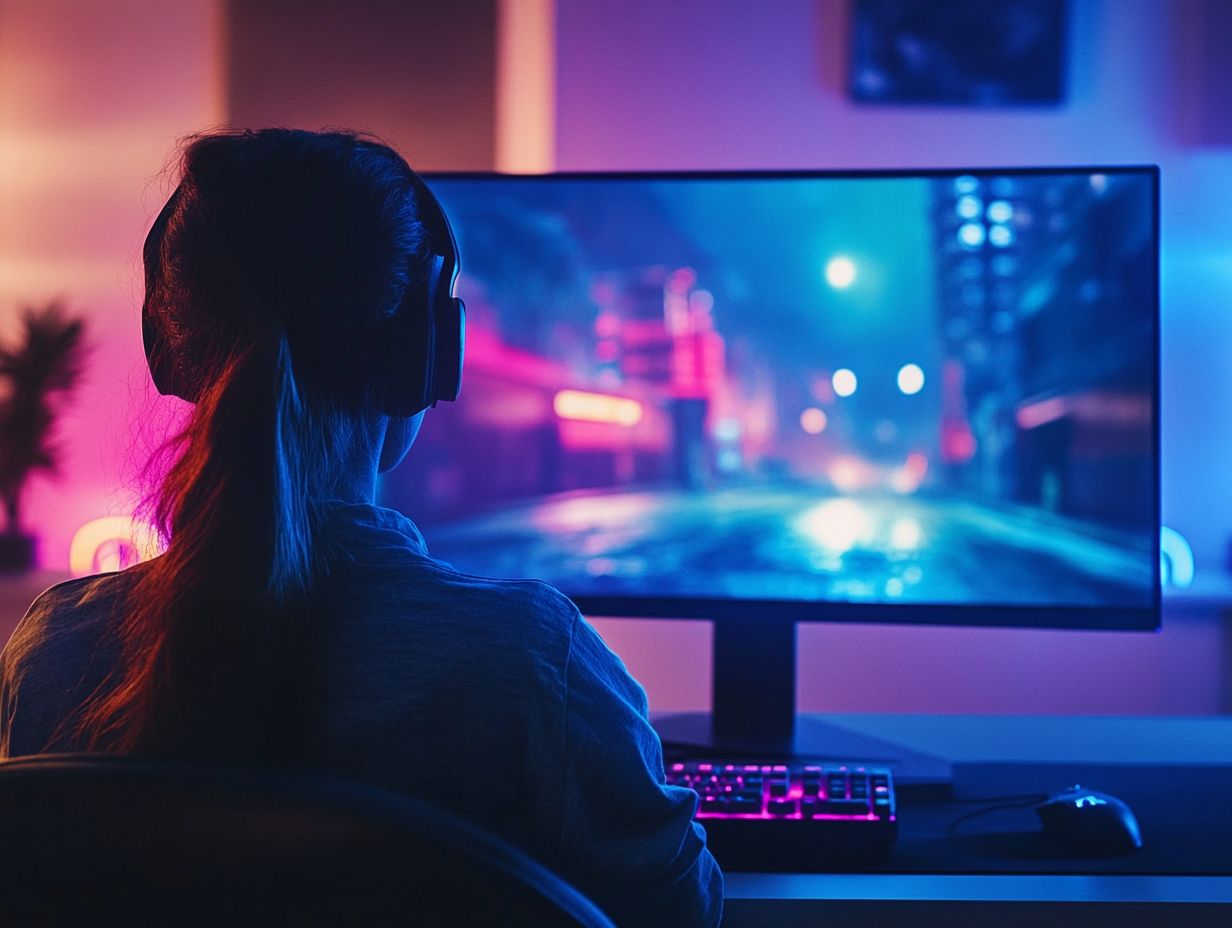
Several factors influence the contrast ratio of your display, including the type of display technology, the effectiveness of local dimming (a feature that adjusts brightness in certain areas for better contrast), and your individual monitor settings. Variations can arise from manufacturing tolerances.
Understanding these elements is vital for anyone eager to optimize their gaming monitor for an unparalleled experience.
Different technologies, like LCD and advanced OLED, present unique capabilities in achieving high contrast levels. Local dimming can dramatically enhance your perception of contrast, resulting in deeper blacks during dark scenes and striking whites in brightly lit moments.
Taking the time to evaluate these factors is essential for elevating your visual clarity and overall performance.
Display Technology and Settings
Various display technologies, including LCD and OLED, employ distinct methods to achieve and manage contrast ratios, significantly affecting overall image quality.
For instance, while LCD panels often depend on backlighting to deliver vibrant colors, their inability to completely turn off individual pixels can lead to lower contrast ratios compared to OLED displays. In contrast, OLED excels because each pixel generates its own light, allowing for true blacks and a more immersive viewing experience. Keep in mind that OLED technology can encounter issues like burn-in over time.
Beyond the inherent traits of these technologies, settings like dynamic contrast can be pivotal in enhancing visual performance. Adjusting brightness levels according to the displayed content can improve depth and clarity. Consequently, thoughtful adjustments in your monitor settings are essential for achieving an optimal viewing experience.
How to Choose the Right Contrast Ratio for Gaming
Choosing the right contrast ratio for your gaming experience requires a keen understanding of your visual preferences and the unique demands of the games you play.
The optimal contrast ratio can differ vastly depending on whether you’re immersed in fast-paced action or exploring atmospheric environments.
Gaming monitors with higher contrast ratios, typically between 2000:1 and 4000:1, deliver sharper image details and enhance immersive experiences.
Contrast measurement and brightness adjustment are critical for perfecting your setup. Evaluate your gaming habits and preferences when selecting the ideal monitor.
Recommended Contrast Ratio for Different Games
The recommended contrast ratio for different games can significantly elevate your visual experience and overall enjoyment.
In first-person shooters (FPS), a higher contrast ratio is essential, allowing you to easily distinguish between shadowy corners and brightly lit areas vital for quickly spotting enemies. Popular titles like “Call of Duty” often leverage stark contrasts to heighten tension and enhance visibility in chaotic scenarios.
On the other hand, role-playing games (RPG) may benefit from a slightly lower contrast, which softens the visuals and fosters an immersive atmosphere that beckons exploration. Games like “The Witcher 3” expertly use nuanced contrasts to showcase the beauty of their rich landscapes and intricate character models.
Developers need to grasp these varying needs to enhance gameplay and keep players engaged.
Maximizing Contrast Ratio in Gaming Monitors
Maximizing the contrast ratio in your gaming monitor is an art that blends precise monitor settings, effective local dimming, and meticulous calibration.
By fine-tuning brightness levels and employing contrast-testing techniques, you can elevate your display to peak performance.
With advanced OLED technology at your disposal, you ll experience superior local dimming, resulting in deeper blacks and brighter whites crucial for an immersive gaming experience.
Paying attention to these details not only enhances image quality but also enriches the overall visual dynamics of your gaming setup, transforming every session into a stunning visual adventure.
Optimizing Settings and Adjustments

Optimizing the settings on your gaming monitor is essential for achieving the best contrast ratio and enhancing visual clarity. This process not only elevates your gaming experience but also helps prevent eye strain during long sessions.
To begin, access your monitor’s on-screen menu and go to the brightness and contrast settings. If you’re gaming in a bright environment, increasing the brightness can be helpful. On the other hand, darker settings can add depth during nighttime gameplay.
Adjusting the contrast is crucial for distinguishing fine details, especially in fast-paced games. Spend some time experimenting with these settings. You’ll be amazed at how much it enhances your gameplay!
Other Considerations for Gaming Monitors
When choosing your gaming monitor, consider factors beyond just the contrast ratio. Elements like resolution, refresh rate, and overall picture quality are important too. Together, they shape your gaming experience, affecting everything from the fluidity of gameplay to the sharpness of images.
To achieve optimal performance, it s vital to balance these components, including contrast measurement, to create an immersive gaming environment.
As a gaming enthusiast, carefully evaluate your needs to select a monitor that meets your demands for stunning visuals and high performance.
Resolution and Refresh Rate
Resolution and refresh rate are key specifications that work with contrast ratio in gaming monitors. They significantly elevate picture quality.
A higher resolution enhances clarity, providing detailed visuals for full immersion in your virtual worlds. Increased sharpness lets you notice subtle differences in texture and depth, adding realism to your gameplay.
The refresh rate of your monitor measured in hertz determines how often the image updates on the screen, playing a vital role in delivering smooth motion. Gaming monitors typically range from 60Hz to over 240Hz. Higher rates offer a more fluid experience, especially in fast-paced action games.
Together, these specifications enhance visual fidelity and your overall performance, enabling swift reactions and effective strategies.
Frequently Asked Questions
What is the role of contrast ratio in gaming monitors?
The contrast ratio shows the difference between the brightest and darkest colors on a monitor. In gaming, it determines the level of detail and depth in images, making it crucial for an immersive experience.
How does the contrast ratio affect image quality in gaming monitors?
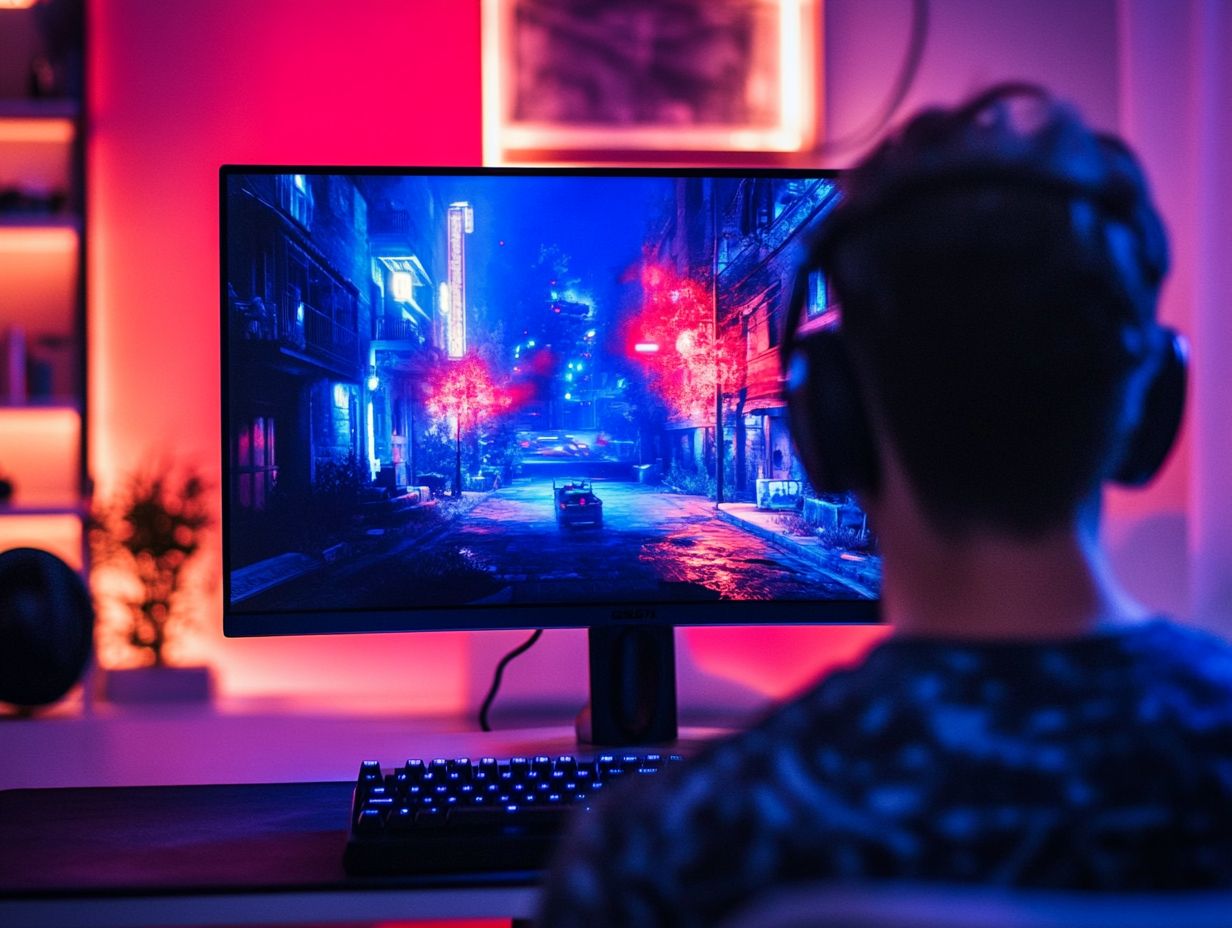
A higher contrast ratio results in more vivid and accurate colors, making images appear more lifelike. This is especially important in dark scenes, where a high contrast ratio ensures that details are not lost in the shadows.
What is a good contrast ratio for gaming monitors?
A good contrast ratio for gaming monitors is typically at least 1000:1. For a truly immersive experience, a contrast ratio of 3000:1 or higher is recommended.
How can a high contrast ratio improve gaming performance?
A high contrast ratio can enhance gaming performance by improving the overall visual experience. With better contrast, gamers can spot enemies or objects more easily, providing a competitive edge and improving reaction times.
Can the contrast ratio be adjusted on a gaming monitor?
Yes, most gaming monitors come with adjustable contrast ratio settings that allow users to customize levels according to their preferences. Remember that a higher contrast ratio may consume more power, so finding the right balance is key.
Are there any downsides to having a high contrast ratio in gaming monitors?
A high contrast ratio can improve your visual experience. However, it may cause a problem known as “black crush.”
Black crush occurs when dark details get lost, appearing as a black blob on the screen. This can lower image quality, so it’s important to consider it when adjusting contrast settings.

